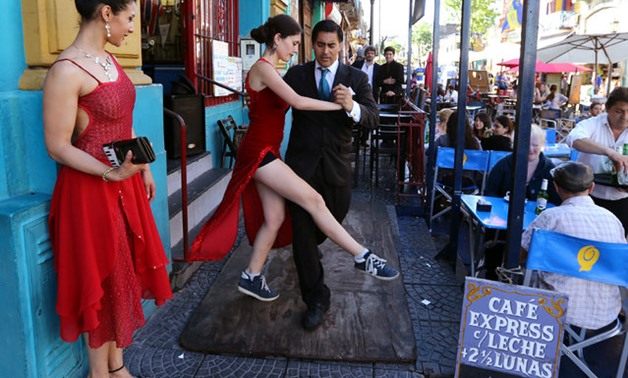
A couple dance tango for tourists at Caminito, a touristic hotspot of La Boca neighborhood in Buenos Aires, Argentina, October 15, 2016. (Photo by Enrique Marcarian/Reuters)
Buenos Aires: Argentines may be feeling the pinch of their country’s economic woes, but for tourists, the troubled peso is proving a holiday boon.
Brazilian Pedro Perreira de Azevedo has been rubbing his hands in delight after his family holiday, with his wife and three children, turned out cheaper than expected.
“We’d planned a budget of 7,000 reais (around $1,700; Dh6,131) but in the end we’ve spent between 3,000-3,500,” said Perreira de Azevedo, while his family took pictures outside the Argentine presidential palace.
When they arrived from Belo Horizonte in the east of Brazil on September 5, the peso had just lost 20 per cent of its value in the wake of President Mauricio Macri announcing Argentina would ask the International Monetary Fund (IMF) to advance a $35 billion loan to help prop up an economy in crisis.
With the peso having lost half its value against the dollar since the start of 2018, the Brazilian real looks strong in comparison despite its own difficulties — it has itself dropped from around 3.3 to 4.1 since January 1.
“We were able to buy whatever we wanted and visit all the tourist sites in Buenos Aires,” added Perreira de Azevedo.
“At Boca Juniors’ stadium we even had a VIP visit!” added one of his daughters excitedly.
Not far from the iconic Bombonera stadium in the rugged La Boca neighbourhood, Lori Berho, an American living in Chile and on holiday with her brother, said she felt lucky to have been able to benefit from such a favourable exchange rate.
“Last night we were able to enjoy a complete restaurant meal for two for $60 when normally it would have cost $100,” she said.
The struggling peso has left tourist guides a touch out of date.
“When you read the tourist guides they say things cost more in Argentina then elsewhere in Latin America, but over the last 10 days we’ve spent less than we expected,” said a young French tourist, Pauline Gauthier, meandering though the historic streets of San Telmo with her partner.
Of course, for Argentines, known as great voyagers, the situation is the exact opposite.
Romanina Valenzisi, a 34-year-old lawyer, booked flights for a two-week holiday to Spain and Italy six months ago.
Now, she must pay for her hotels in Europe, but their prices have gone through the roof.
In January, 18 pesos could be exchanged for one dollar, but that figure is now around 38.
“I have to pay for the hotels now and everything costs double, which is coming out of my budget,” she said.
“I already know that I’ll spend less money and buy less [while on holiday].”
Travel agents have been hard hit too as holidays have crept out of reach for many people.
“Sales of foreign travel have dropped 25-30 per cent over the last few weeks,” said Vincent Chevalier, a Frenchman who has run a travel agency in Buenos Aires for the last 28 years.
“The crisis is also starting to affect internal tourism.”
Even the centre of Buenos Aires has been hit, as hotelier Gonzalo Sastre has found out.
“When the peso had a ‘normal’ level, we had a good stream of locals during the week, basically people who came for work,” he said.
“Now, companies are sending fewer employees.”
Even so, his hotel is booked out for the next two weeks, thanks to Brazilians.
“In this region there’s a very opportunistic tourism based around the drop in currency,” added Chevalier.
Argentina’s problems may improve the spending power of its visitors, but it’s proving a problem for neighbouring countries used to welcoming large numbers of Argentines, in particular Uruguay and Chile.
Uruguay is so worried that the numbers will drop off that it has reintroduced a value-added tax (VAT) exemption for tourists arriving from the far shore of the River Plate in a hope to keep the flow of Argentines flooding into the country during the January-February summer holidays.


Comments
Leave a Comment